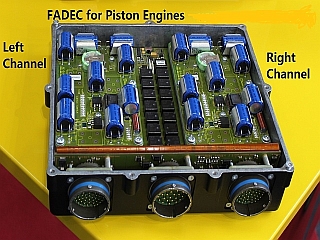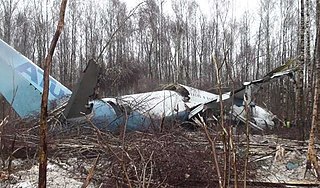Related Research Articles

Avionics are the electronic systems used on aircraft. Avionic systems include communications, navigation, the display and management of multiple systems, and the hundreds of systems that are fitted to aircraft to perform individual functions. These can be as simple as a searchlight for a police helicopter or as complicated as the tactical system for an airborne early warning platform.

Fly-by-wire (FBW) is a system that replaces the conventional manual flight controls of an aircraft with an electronic interface. The movements of flight controls are converted to electronic signals transmitted by wires, and flight control computers determine how to move the actuators at each control surface to provide the ordered response. It can use mechanical flight control backup systems or use fully fly-by-wire controls.

Automation describes a wide range of technologies that reduce human intervention in processes, namely by predetermining decision criteria, subprocess relationships, and related actions, as well as embodying those predeterminations in machines. Automation has been achieved by various means including mechanical, hydraulic, pneumatic, electrical, electronic devices, and computers, usually in combination. Complicated systems, such as modern factories, airplanes, and ships typically use combinations of all of these techniques. The benefit of automation includes labor savings, reducing waste, savings in electricity costs, savings in material costs, and improvements to quality, accuracy, and precision.

An autopilot is a system used to control the path of an aircraft, marine craft or spacecraft without requiring constant manual control by a human operator. Autopilots do not replace human operators. Instead, the autopilot assists the operator's control of the vehicle, allowing the operator to focus on broader aspects of operations.

A dead man's switch is a switch that is designed to be activated or deactivated if the human operator becomes incapacitated, such as through death, loss of consciousness, or being bodily removed from control. Originally applied to switches on a vehicle or machine, it has since come to be used to describe other intangible uses, as in computer software.

A full authority digital enginecontrol (FADEC) is a system consisting of a digital computer, called an "electronic engine controller" (EEC) or "engine control unit" (ECU), and its related accessories that control all aspects of aircraft engine performance. FADECs have been produced for both piston engines and jet engines.

In aviation, autoland describes a system that fully automates the landing procedure of an aircraft's flight, with the flight crew supervising the process. Such systems enable airliners to land in weather conditions that would otherwise be dangerous or impossible to operate in.

Pilot error generally refers to an accident in which an action or decision made by the pilot was the cause or a contributing factor that led to the accident, but also includes the pilot's failure to make a correct decision or take proper action. Errors are intentional actions that fail to achieve their intended outcomes. Chicago Convention defines accident as "An occurrence associated with the operation of an aircraft [...] in which [...] a person is fatally or seriously injured [...] except when the injuries are [...] inflicted by other persons." Hence the definition of the "pilot error" does not include deliberate crash.
A takeoff/go-around switch is a switch on the autothrottle of modern large aircraft, with two modes: takeoff (TO) and go-around (GA). The mode is dependent on the phase of flight; usually, on approach to land, the autopilot will be set to approach mode, therefore if the TO/GA switch is pressed it will activate the go-around mode of the autothrottle; conversely, when takeoff is set on the autopilot, the switch activates takeoff mode of the autothrottle. On Boeing aircraft TO/GA modes are selected by a separate switch near the throttle levers, but on Airbus aircraft it is activated by pushing the thrust levers fully forward to the TO/GA detent.

An autothrottle is a system that allows a pilot to control the power setting of an aircraft's engines by specifying a desired flight characteristic, rather than manually controlling the fuel flow. The autothrottle can greatly reduce the pilots' work load and help conserve fuel and extend engine life by metering the precise amount of fuel required to attain a specific target indicated air speed, or the assigned power for different phases of flight. A/T and AFDS can work together to fulfill the whole flight plan.
A yaw damper is a system used to reduce the undesirable tendencies of an aircraft to oscillate in a repetitive rolling and yawing motion, a phenomenon known as the Dutch roll. A large number of modern aircraft, both jet-powered and propeller-driven, have been furnished with such systems.
An annunciator panel, also known in some aircraft as the Centralized Warning Panel (CWP) or Caution Advisory Panel (CAP), is a group of lights used as a central indicator of status of equipment or systems in an aircraft, industrial process, building or other installation. Usually, the annunciator panel includes a main warning lamp or audible signal to draw the attention of operating personnel to the annunciator panel for abnormal events or condition.

Flight envelope protection is a human machine interface extension of an aircraft's control system that prevents the pilot of an aircraft from making control commands that would force the aircraft to exceed its structural and aerodynamic operating limits. It is used in some form in all modern commercial fly-by-wire aircraft. The professed advantage of flight envelope protection systems is that they restrict a pilot's excessive control inputs, whether in surprise reaction to emergencies or otherwise, from translating into excessive flight control surface movements. Notionally, this allows pilots to react quickly to an emergency while blunting the effect of an excessive control input resulting from "startle," by electronically limiting excessive control surface movements that could over-stress the airframe and endanger the safety of the aircraft.

A flight control mode or flight control law is a computer software algorithm that transforms the movement of the yoke or joystick, made by an aircraft pilot, into movements of the aircraft control surfaces. The control surface movements depend on which of several modes the flight computer is in. In aircraft in which the flight control system is fly-by-wire, the movements the pilot makes to the yoke or joystick in the cockpit, to control the flight, are converted to electronic signals, which are transmitted to the flight control computers that determine how to move each control surface to provide the aircraft movement the pilot ordered.

Aviastar-TU Flight 1906 was a Tupolev Tu-204 that crash-landed while attempting to land at Domodedovo airport, Moscow, Russia, in heavy fog on 22 March 2010. The aircraft of Aviastar-TU Airlines was on a ferry flight from Hurghada International Airport, Egypt to Domodedovo. There were no passengers on board and all eight crew survived the accident; four crew members were seriously injured and taken to a hospital, while others suffered minor injuries. The accident was the first hull loss of a Tu-204 and the first hull loss for Aviastar-TU.
The gyroscopic autopilot was a type of autopilot system developed primarily for aviation uses in the early 20th century. Since then, the principles of this autopilot has been the basis of many different aircraft control systems, both military and civilian.

Bhoja Air Flight 213 was a domestic scheduled passenger flight operated by Pakistani airline Bhoja Air from Karachi to Islamabad. On 20 April 2012, the Boeing 737-236A aircraft serving the route crashed in bad weather during its final approach to land. All 121 passengers and 6 crew members aboard were killed. With 127 deaths, it remains as the second deadliest air disaster in Pakistan.
Automation bias is the propensity for humans to favor suggestions from automated decision-making systems and to ignore contradictory information made without automation, even if it is correct. Automation bias stems from the social psychology literature that found a bias in human-human interaction that showed that people assign more positive evaluations to decisions made by humans than to a neutral object. The same type of positivity bias has been found for human-automation interaction, where the automated decisions are rated more positively than neutral. This has become a growing problem for decision making as intensive care units, nuclear power plants, and aircraft cockpits have increasingly integrated computerized system monitors and decision aids to mostly factor out possible human error. Errors of automation bias tend to occur when decision-making is dependent on computers or other automated aids and the human is in an observatory role but able to make decisions. Examples of automation bias range from urgent matters like flying a plane on automatic pilot to such mundane matters as the use of spell-checking programs.

Total Linhas Aéreas Flight 5561 was a domestic cargo flight from São Paulo, Brazil to Londrina, Brazil that crashed near Paranapanema 47 minutes after take off on September 14, 2002. The crew of the ATR 42 regional turboprop lost control of the aircraft's pitch and were both killed in the accident.

Loganair Flight 6780 was a scheduled domestic flight from Aberdeen Airport to Sumburgh Airport in the Shetland Islands, Scotland. On 15 December 2014, the Saab 2000 operating the flight was struck by lightning during the approach, and then plunged faster than the aircraft's maximum operating speed. The aircraft came within 1,100 feet (340 m) of the North Sea before the pilots recovered and returned to Aberdeen. All 33 passengers and crew were unharmed.
References
- ↑ Manual override Archived 2006-05-13 at archive.today , Ambitions Photography Academy.
- ↑ 'Raw deal' on printer ink, BBC , 3 July 2003
- ↑ Marc Langheinrich; Vlad Coroama; Jurgen Bohn & Michael Rohs, As we may live – Real-world implications of ubiquitous computing (PDF), Institute of Information Systems
- ↑ Asaf Degani (2004), Taming HAL: designing interfaces beyond 2001, p. 151, ISBN 978-0-312-29574-5